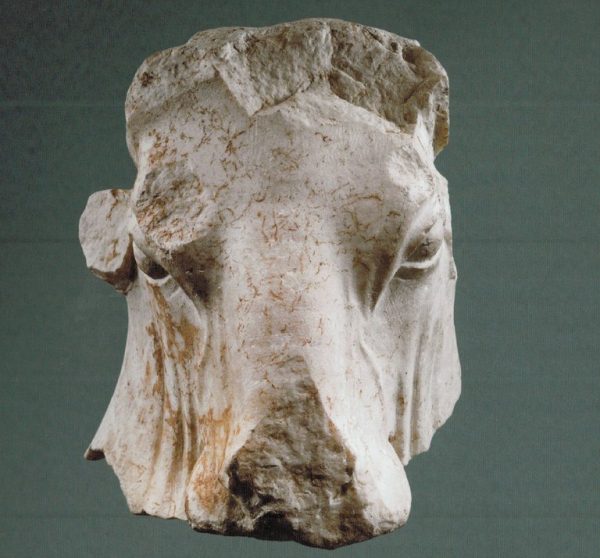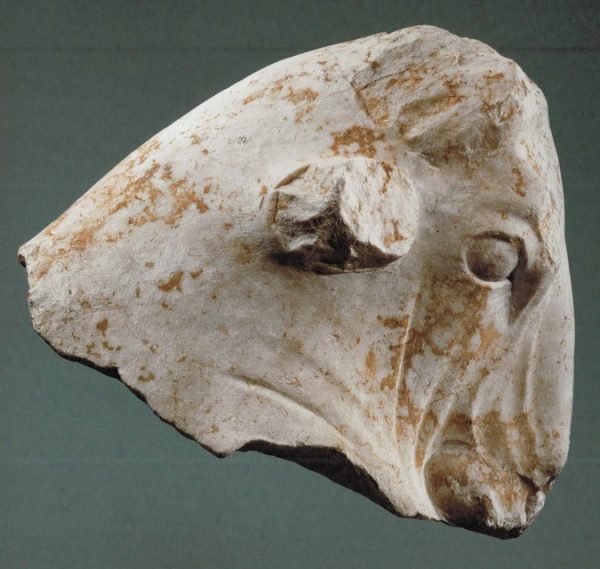
Two months after authorities seized an ancient head of a bull that was on loan to the Metropolitan Museum of Art in New York, a senior official in the Manhattan District Attorney’s office says, in no uncertain terms, that the marble sculpture should be returned to Lebanon. The claim is the latest chapter in an ongoing dispute between the Lebanese government and a pair of Colorado collectors over the antiquity’s rightful ownership.
This past Friday, Matthew Bogdanos, senior trial counsel of the New York County DA’s office, submitted a 68-page document to the New York State Supreme Court, arguing that his office has proven the 2,300-year-old bull’s head is stolen property and should be returned to Lebanon.
This ancient bull head may have been looted to from Lebanon. The Metropolitan Museum of Art, where it was on loan, has turned it over to the Manhattan DA. Courtesy of William and Lynda Beierwaltes.
But two Colorado collectors, Lynda and William Beierwaltes, believe otherwise. They are suing both the director general of antiquities (DGA) for the republic of Lebanon, as well as the the Manhattan DA, arguing that they have title to the head and should be allowed to keep it. They also argue that the statute of limitations for any claim has expired. Their attorney did not respond to a request for comment, but he told the New York Times last month that the couple “are bona fide purchasers with clean hands” and that Lebanon had failed to take any action concerning the bull’s head for more than 50 years.
 The legal saga stretches back to 2010, when the Beierwaltes sold the bull’s head to collector Michael Steinhardt through New York dealer Hicham Aboutaam, owner of Phoenix Ancient Art Gallery. Steinhardt promptly loaned the head to the Metropolitan Museum of Art. But in 2014, when a curator alerted Met authorities that there were problems with the provenance of the object, Steinhardt sought and received his money back from the Beierwaltes.
The legal saga stretches back to 2010, when the Beierwaltes sold the bull’s head to collector Michael Steinhardt through New York dealer Hicham Aboutaam, owner of Phoenix Ancient Art Gallery. Steinhardt promptly loaned the head to the Metropolitan Museum of Art. But in 2014, when a curator alerted Met authorities that there were problems with the provenance of the object, Steinhardt sought and received his money back from the Beierwaltes.
After museum officials handed over the object to the Manhattan DA this past summer, the Beierwaltes filed suit on July 11 in US District Court.
In his report, which asks the judge to authorize the object’s transfer to Lebanon, Bogdanos refutes the Beierwaltes’ arguments point by point and adds the results of his own interviews and research. A summary of the key findings he presents is below.
- The Bull’s Head was excavated in 1967 and stolen in 1981 during a brutal civil war in the Lebanese Republic, almost 50 years after the country enacted laws that claim ownership of all antiquities discovered there.
- The next time the Bull’s Head surfaced was in the hands of Robin Symes in New York in early 1996. Italian authorities have revealed that Symes was a key player in a global antiquities trafficking network during this period (the 1980s and 1990s). Bodganos says he could find no evidence of how Robin Symes acquired the Bull’s Head or whether he “had a legal right to possess it.”
- Ninety-eight percent of the vast Beierwaltes collection, which was valued at almost $100 million in 2006, according to the filing, passed through Symes.
- There is a “staggering lack of any documentation” produced by the Beierwaltes related to the antiquity between the years 1981 and 2004, the filing claims—except for a single-page invoice allegedly prepared by Robin Symes.
- There is a “complete absence of any documented evidence whatsoever” that the Beierwaltes, despite their years of experience in buying and selling antiquities, made any inquiry to Robin Symes about the provenance of the Bull’s Head before they bought it from him in 1996.
The Beierwaltes’s attorney has not responded to request for comment about the latest DA filing.
ARTNET
Leave a Reply
You must be logged in to post a comment.